A journey to Bangladesh’s Sundarbans, the world’s largest contiguous mangrove forest, where rising waters threaten the future of a fragile environment.
One afternoon three years ago, a tiger attacked Kamal Gazi as he was fishing on a riverbank in the mangrove forests of the Sundarbans. It is a miracle he is alive. The scars on his face start at the eyes and wrap around his head where black hair unevenly stripes his puckered scalp.
Gazi was fishing with a fellow villager who bravely managed to beat off 450 pounds of feline muscle with a stick. That’s how he survived an attack by one of the infamous man-eating tigers of the Sundarbans, the world’s largest contiguous block of mangroves covering southwest Bangladesh. So much for the myth that these swimming tigers attack only from behind and never in broad daylight. Gazi was lucky; at least 50 people are killed by tigers each year here.
As the 29-year-old describes his close call with the tiger, people crowd around us in this village in Koyra on a sweltering March afternoon. He has other scars. Gazi opens the collared button-down shirt he wears atop his lungi, the cotton sarong men wear, to reveal a lean chest. The skin and flesh of his shoulder is cruelly dimpled, his chest gashed where teeth and claws tore into muscle. He still squints from an eye infection. Does he fish in the forest anymore? I ask. Gazi shakes his head. Since the attack he hasn’t ventured back into the mangroves.

Life is precarious for villagers like Gazi who live on the edge of the Sundarbans and enter the forest to fish, harvest palm leaves for thatch roofing, and collect wild honey. He used to make up to 5,000 taka ($65) each month from fishing in the tidal salt creeks that run throughout the forest like capillaries, but after the attack, Gazi couldn’t work. A non-profit called Relief International eventually granted him money to start a simple shop of wooden boards and dusty sundries. Now the soft-spoken young man supports his wife and two young sons with 2,500 to 3,000 taka ($32 to $39) earned each month from the store and odd jobs.
Standing in the small crowd next to Gazi is a thin older man with a weathered face. He unselfconsciously pulls up his lungi to reveal crevice-like scars on his thigh, dangerously close to the groin. Many still risk their lives in the Sundarbans because they have no other choice.

I’m on a reporting trip in southern Bangladesh to learn about how locals near the Sundarbans are living and coping with the threat of violent storms, rising water, and other changes to this highly vulnerable environment. In development jargon this is called “adaptation to climate change” and I’ve tagged along with workers from Relief International and other aid agencies to understand how these fragile communities will survive the incredible challenges before them.
Over 700 rivers thread Bangladesh—of the world’s largest deltas where the Ganges, Jamuna and others converge and eventually empty into the Bay of Bengal. In Koyra, land once lush with jackfruit, mango and coconut trees and rice paddies was inundated with salt water for more than two years after Cyclone Aila in 2009. A tidal surge flooded precious farmland in this densely packed country and broke embankments holding back tidal rivers. When the waters finally receded, the land was rendered a moonscape of saline soil. Concrete buildings still bear ragged, chest-high stains where water once reached.
This is a country raised on disaster
The Bay of Bengal forms a dangerous funnel into Bangladesh, making this low-lying country especially vulnerable to tropical storms. More than 300 people died in Cyclone Aila – a low figure compared to the devastation of other storms like a 1970 cyclone that killed a staggering 460,000 people. In Dhaka I saw photos of victims of a 1991 cyclone that killed 190,000 people showing swollen, muddy corpses of men, women and children, their eyes black and rotted.
Still, Aila affected three million people, destroying homes, crops, livestock, tools, and filling ponds used for drinking with salt water. “This is a country raised on disaster,” a UN disaster relief specialist in Dhaka, the capital, told me.
While Gazi doesn’t go into the forest anymore plenty of others do. A couple miles away, I observe a seminar for honey collectors in a small community hall. Relief International is also training villagers to collect honey in a sustainable way. Agricultural experts teach them which kinds of flowers produce the best honey and how to cut off only parts of the honeycomb without destroying the hive.
None of them want to see a tiger. If they do, it may be the last thing they ever see
Although their father and grandfathers collected honey, this advice is new to the 40 or so older, uneducated men who crowd the room. I ask how many of them have seen tigers and the room ripples. Half of the men raise their hands. Tourists who visit the Sundarbans yearn for a rare tiger spotting. But for these villagers it is a dreaded occupational hazard. None of them want to see a tiger. If they do, it may be the last thing they ever see.
Yet villagers are eager to supplement their meagre income with lucrative honey from the Sundarbans. The work is dangerous but Cyclone Aila left them few ways to make a living. It is the end of March and the official honey collection season starts April 1 when the government issues permits allowing people into the Sundarbans.
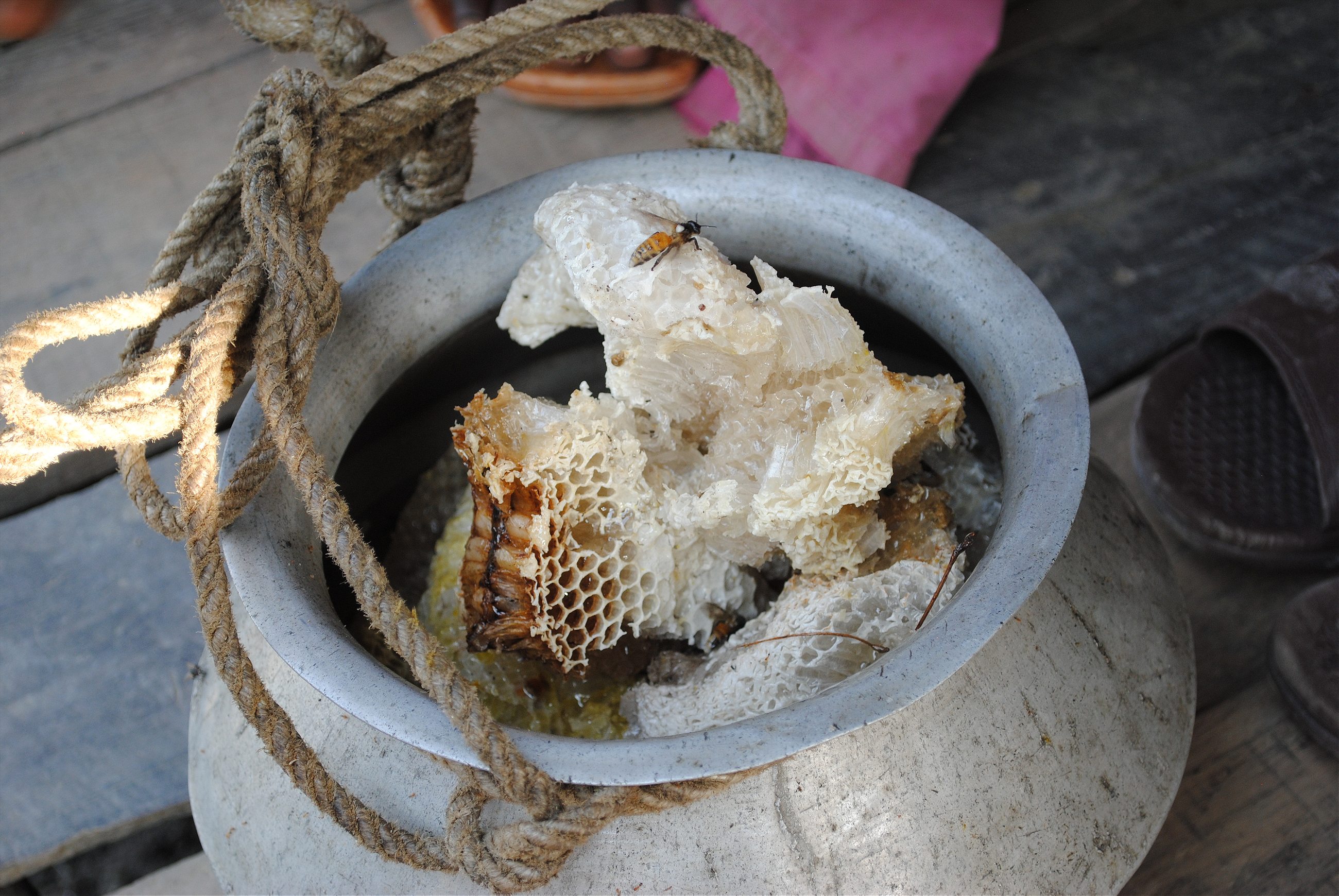
One young man couldn’t wait. On the edge of a riverbank, 28-year-old Saiful Islam squats outside his thatch home where his wife and two sons, ages 2 and 4, also live. He went into the forest alone that morning and emerged with honey five hours later. Islam squeezes the chunks of honeycomb like big sponges over a battered metal pot so they drip clear streams of sweet liquid. The geometric chambers of the greyish honeycomb resemble scaly fish hunks. Islam picks dead bees out of the honey, then strains it with the blue plastic mesh of a fishing net into a plastic bottle. Two kilograms will earn him 700 taka, about $9.
Islam’s family was out of food. Honey is the quickest way to make money so he went five miles into the forest, and climbed an 18-foot tree after smoking bees from their hive. A long sleeved shirt over his lungi, a scarf over his face, and a red string folk amulet wound around his bicep were his only protection. Even the Bangladeshi Relief International workers accompanying me remark on his courage. A gaggle of children and neighbors gather around Gazi to admire the year’s first honey harvest. Gazi’s wife says she prays to ‘’almighty Allah’’ to keep her husband safe when he crosses the river and disappears into the mangroves.

Between work visits, I take a three-day boat trip from the bustling port city of Khulna into the quiet deep of the Sundarbans. As we plow southward, the human bustle of Bangladesh slowly diminishes. The boat journeys through a molten mango sunset until night envelops us.
Here, the air is cooler and the mosquitoes swarming the city have vanished. Branches stretch from the riverbank over the water like shelves as we push through a smaller inlet. Then within the leafy masses comes the bluish electric sparkle of nature’s Christmas lights: fireflies. We pass a flimsy dinghy where locals harvest huge nipa palm leaves in the dark in spite of the tigers, crocodiles, snakes, and other creatures lurking in the forest.
Humanity buzzes everywhere in Bangladesh, where 153 million people are packed into a space smaller than Iowa, making it the world’s most densely populated country. Every inch of countryside is covered with a tight patchwork of chartreuse rice paddies, murky ponds a stone’s throw from the road, electricity pylons and brick kiln smokestacks puffing black exhaust plunked down among the fields.
All that is a world away within the Sundarbans. It is the only place in all of Bangladesh I do not hear the call to prayer. There is only a symphony of chittering insects, the guttural bass of frogs, and water lapping against the hull when the boat’s engine stops.
We spot the wet indentations of a tiger’s paw prints in the mud
Morning reveals the forest’s beauty. Just after dawn we load into a wooden boat powered by a man levering a long oar back and forth. We paddle silently into a creek so narrow one can almost touch the branches of these strange trees that grow in brackish water and excrete salt through their bark, roots, and leaves. Some mangroves have tangled networks of aerial roots that lift the tree above water like stilts. Other trees have roots that poke like sinister spikes out of the mud. This is nature’s innovative design to let trees breathe oxygen while immersed in salt water. It is an otherworldly sight, from the stuff of dark fairy tales.
Amid roots studding the ground, we spot the wet indentations of a tiger’s paw prints in the mud. There are no tigers to be seen among the shadowy tangle of trees covering the shore, but soon a slick brown otter crawls out of the water and quickly scrambles up the riverbank into the trees.
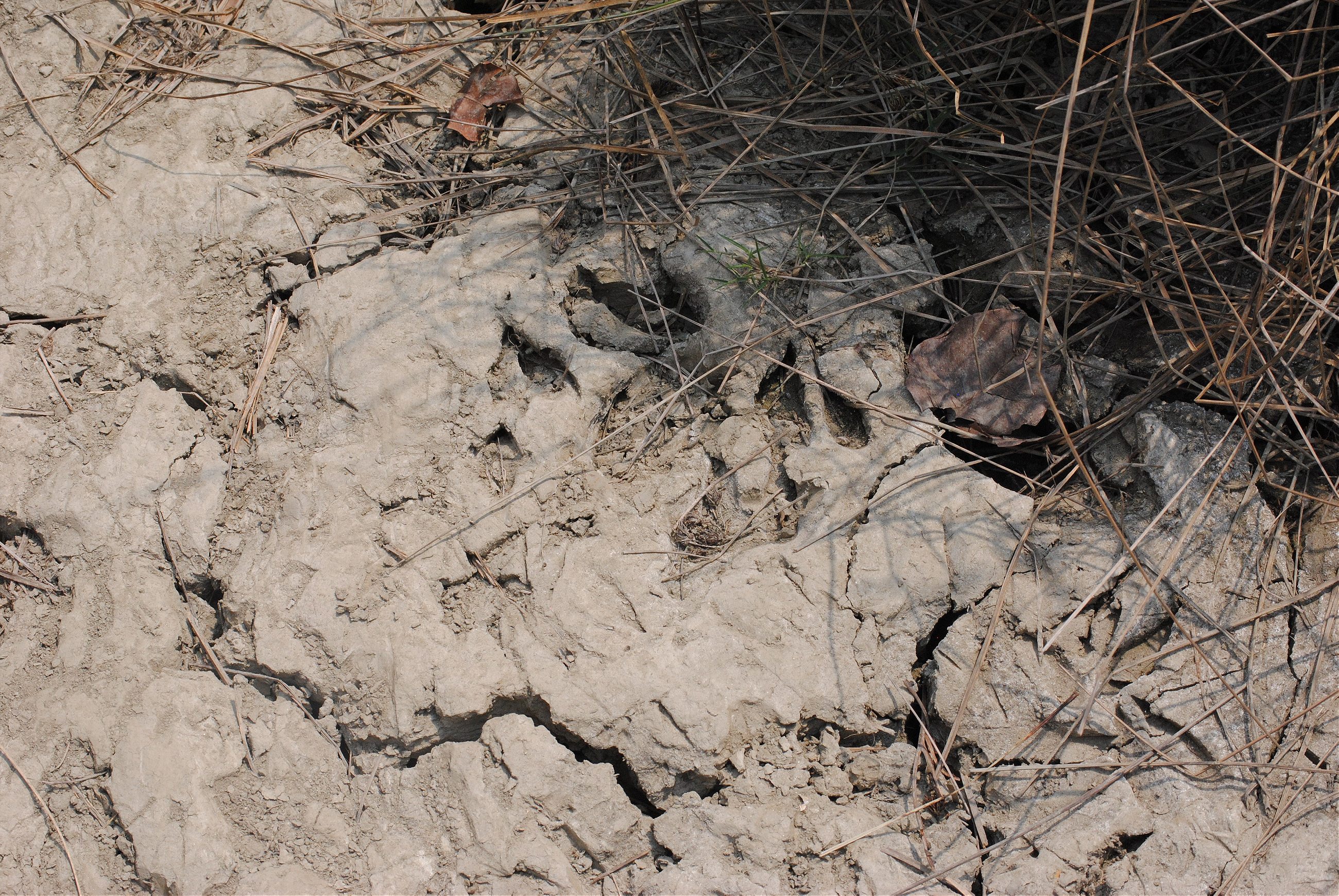
The Sundarbans teems with life in its 6,000 square miles (more than five times the size of Yosemite National Park) covering southwest Bangladesh and part of India. Even men attacked by tigers who have cruel scars calmly explained that “if the tigers were not there, we would not be here.” Without these fierce guardians, the forest would have been plundered of its resources long ago.
Our boat slips further into the creek. Silence is broken when a green coconut-like fruit from a cannonball mangrove plunges into the water. A thin green snake barely distinguishable from a vine slithers along a web of branches. As the rising sun starts to burn off the mist, furry monkeys traverse the creek via thin branches forming a natural bridge above.
The creeks and inlets of the Sundarbans shift according to the ceaseless motion of tides. Mud and silt from upstream form new land masses while others erode and crumble away. It is a forest that is both dense and menacing, but also shifting, life-giving, and fragile. The delicate balance of the Sundarbans is threatened by more frequent, violent storms brought on by climate change, and rising waters that gnaw away at land where plants and animals vie for life.
Later that morning we ascend the riverbank along the same creek. The dark forest opens into an expansive green meadow bisected by a sandy path. It is a far more hospitable environment for tigers, deer, wild boar, and monkeys than muddy ground covered with wooden spikes.
The sandy trail leads to Jamtala Beach on the rim of the Bay of Bengal stretching into the horizon. The beach is blissfully deserted and its salt-and-pepper sand extends for miles. The landscape is dotted with battered skeletons of once-massive trees and bleached tree trunks. Other trees are broken like snapped pencils, destroyed by the force of Cyclone Sidr in 2007, which killed 3,000 people in Bangladesh.
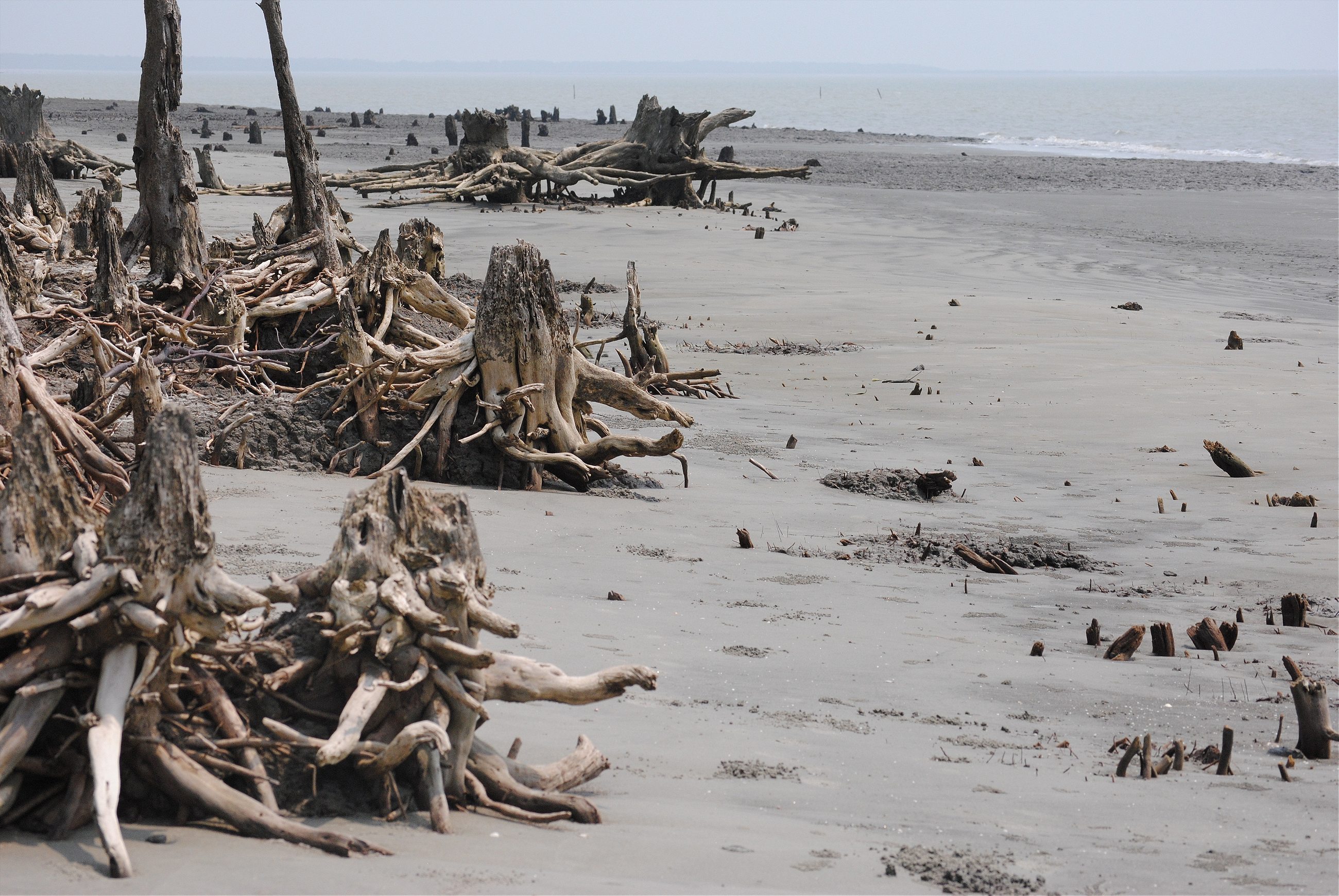
Under a calm azure sky I step into the sea, warm as bathwater. My toes sink into a slimy, muddy bottom. Soon others in the group are smearing the crab-gray mud on their chests and faces like war paint.
I think about a textile factory I visited on the outskirts of Dhaka a week before. It is one of the Bangladesh’s biggest makers of cotton fabric and garments and has the resources and foresight to build a multi-million dollar wastewater treatment plant. Each day the factory uses 900,000 gallons of water – 1.5 Olympic swimming pools – to make the vibrant hues we wear every day: my favorite teal T-shirt and those skinny dark denim jeans. Before it built the effluent treatment plant it did what most Bangladeshi factories do – dump the black bruise-colored water full of dyes and chemicals into nearby rivers that eventually flow into the sea.
Later that night our boat turns and starts to nose its way north for our return journey to Khulna. I take a seat on the boat’s top deck. Next to me is an older, white-haired Canadian man based in Singapore, visiting his nephew who is studying in Bangladesh. He is a zealous bird-watcher who wears binoculars around his neck and calls out species by sight during our morning boat ride through the creek: magpie robins, gray malkohas, green leaf birds with golden foreheads. He travels the world for his hobby and meticulously logs all birds sighted into a notebook.
When I ask what brings him to Singapore, he replies, ‘’Looking for buried treasure.’’ He is a geophysicist for an oil company prospecting across Asia. I ask him about fracking, the controversial new method of oil and gas extraction, and he confirms that no one fully understands the risks. That hasn’t stopped an energy gold rush in North America.
The Canadian regretfully adds that fracking kills any hope of curbing carbon emissions. With this new wealth of oil and gas, there is little incentive to invest more heavily in solar, wind, biofuel, biomass, hydrogen or geothermal – alternative energy within our reach but that requires effort to pluck. The geophysicist waves his hand out over the dark river toward the leafy mass of the Sundarbans, a thriving bird habitat that made him swoon for the last couple days. “In a hundred years this will all be under water.”
***
A few days later, I am on a much smaller boat heading to Bainpura village on another river in the Sundarbans. Bainpura is home to development projects to help locals recover and rebuild after violent storms, and I want to see the progress. We ride in a traditional wooden vessel painted turquoise with red trim whose engine makes a chopper-like ruckus. A young man in a lungi who calls me “sister” steers. His 12-year-old assistant holds a black umbrella to shade us from the scorching sun. I sit cross-legged on top of the cabin for a front-row seat to life in the Sundarbans. Men on the riverbank fling cast nets into the water. Women bathe while wearing salwar kameez tunics and squeeze suds from their wet hair. Bare-skinned children splash and laugh.
The boat hugs the shoreline close to a riverbank crumbling into the water in wet chunks. Slender trees are already half immersed in water, not waving but drowning, and enormous parrot-hued leaves of nipa palm grow like seven-foot tall feathers in the water. When dried, these leaves will make thatch roofs that last for years while regular palm leaves disintegrate after months.
We arrive at Bainpura around noon when the sun is a hot white disc overhead. There are no real roads here, just sand and gravel paths between 55 small houses. The nearest marketplace is half a day’s walk along a dirt road on the disintegrating riverbank.
Bangladesh lacks the resources to fortify itself against rising water
Bainpura was badly affected by Cyclone Aila in 2009. Most people in this remote village were too poor to move after homes and belongings were washed away. Thousands lived on the embankment for more than a year. They relied on handouts of water and food from relief agencies after crops were destroyed and freshwater ponds contaminated with salt water.
As global temparatures climb and sea levels rise, millions more could be similarly affected around the world. Bangladesh lacks the resources to fortify itself against rising water, more storms and floods, unlike rich countries like low-lying Netherlands. By the end of the 21st century, rising sea levels are expected to affect 94 million people in low-lying parts of Asia—including one million in Bangladesh, according to the UN’s Intergovernmental Panel on Climate Change. Of course, the Sundarbans is highly vulnerable.
Countless people must adapt to climate change as best they can. Bainpura is fortunate. It is the site of a 2011 pilot program funded by a bevy of European and Australian aid agencies and the United Nations Development Program. After villagers were trained to grow crops other than rice, vegetable plots are flourishing, and lush creeping vines sprout gourds on rooftops. All this seems rather miraculous considering the gritty sand underfoot.
New concrete homes stand in neat rows on thick foundations. These one-room cyclone-resistant houses were designed by the Housing and Building Research Institute in Dhaka to withstand winds of up to 135 miles an hour. They have wavy concrete roofs with small detachable solar panels instead of the usual corrugated metal sheet that becomes a flying hatchet when loosened by cyclone winds. I peek inside one of the homes where a baby is sleeping under a large net and a young mother bustles about. As in many poor homes, the only furniture is a bed and clothes hang from wooden rods strung up on the whitewashed walls. A sonorous midday call to prayer warbles over the village like a mournful lullaby.
Outside every house there is a large plastic vat for collecting rainwater, as well as a booth-like latrine with a bright blue door on thick concrete foundations. Near the ponds are large domed sand filters where people can pump clean drinking water.
In the aftermath of a cyclone, access to clean drinking water and sanitation are major problems. Thousands of homeless resort to open defecation in close quarters. Today children are frolicking in one of the small ponds alongside fleets of bobbing, quacking ducks. After a cyclone these ponds become contaminated with salt water and refuse. Typhoid, hepatitis, dysentery, and other water-borne diseases can lead to more deaths after the storm.

As we walk through the village, a man named Yasin Alam joins us. The 35-year-old carpenter is the village representative to the NGOs and donors re-building Bainpura. He remembers swimming for his life during Cyclone Aila but he and his three children survived. Bangladesh does have an effective national cyclone warning system where alerts are conveyed from Dhaka to 49,000 volunteers on the ground equipped with radios and megaphones to urge villagers to evacuate. Alam heard the warnings before Aila struck, but didn’t flee to the concrete shelter about a mile away. It was too far and crowded, he says.
Now a new two-story concrete cyclone shelter in the village is almost finished. The ground floor is an elevated, open area where people can bring goats, chickens and other livestock. The second floor rests on thick pillars and can hold at least 1,000 people. We sit on plastic chairs on the shady ground floor where a kid goat on spindly legs noses a plastic wrapper wedged between bricks. I pause in our conversation to wrest it from the animal’s mouth. The villagers laugh and one jokes that this is an example of climate change: not enough fodder for animals.
Alam says life is much better with these new houses and he feels more prepared for the next storm. Yet he points across a dry field where a long row of huts sits on the embankment. Thousands remain homeless even four years after Aila. There aren’t enough funds to help everyone, especially during the economic downturn. In a strong storm those puny thatch shelters would be ripped apart, but there is no place for them to go. Villagers will stay even as the river rises and ponds recede. A man from a local NGO follows my gaze to the thatch homes in the distance and remarks, “There is no scope for these people to escape the embankment.”
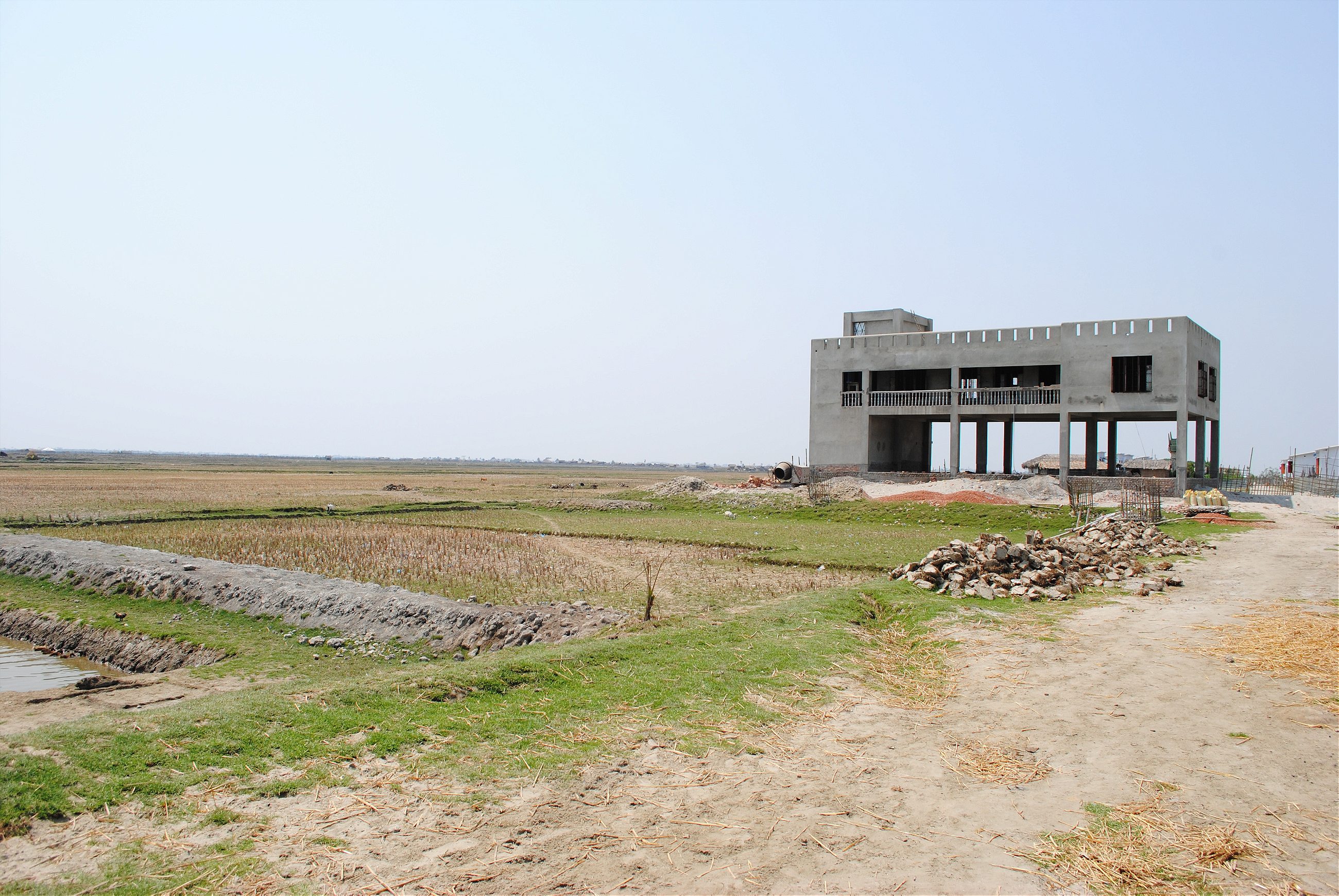
Another boat ride takes me to a village in Dacope district called Banishanta. Sixteen thousand people live in this cluster of villages, which was spared the full brunt of Cyclone Aila in 2009. The village was flooded for only five days, unlike two years in Koyra to the east, but it is readying for coming storms.
Banishanta now has better access to drinking water. A short walk from the pier, a dozen women in bright saris gather near a spigot. They fill their metal urns with water and elegantly balance them on their heads for the walk home. Taslima Begum, 35, used to walk a mile and a half at least twice a day to get drinking water but now she walks a short way to the spigot.
Old habits are hard to break: a girl scoops water from the green pond in her hand and drinks
I get on the back of a motorbike and we zip along a narrow path past picturesque rice fields and ponds for a couple miles. The path is paved with bricks, courtesy of JICA, Japan’s aid agency. We visit the pond where water is pumped into a two-story tower topped with solar panels, filtered, then pumped to 11 spigots in the area. The contraption funded by Germany aid agency GiZ filters 15,000 liters a day with sand and carbon technology and can withstand cyclones.
There is a school on the other side of the pond and children in uniforms spill outside. Old habits are hard to break: a girl scoops water from the green pond in her hand and drinks. The school doubles as a cyclone shelter, hence its utilitarian block-like concrete structure. Now shelters serve as schools or community halls so they remain well-maintained throughout the year in central locations instead of falling into disrepair.
Large domed structures for storing rainwater dot the village, like one next to a small mosque. It holds 10,000 liters and can supply water for months. People used to buy water or drink pond water but the rainwater is clean and free, explains imam Mohammed Showkat Osman. The 50-year-old imam pauses to take a photo of me with his mobile phone as a few fuzzy lambs trot past.
In a tranquil cluster of thatch and bamboo homes there are manually operated pond-sand filters, new latrines, and black plastic vats for harvesting rainwater. It is an idyllic setting among groves of coconut, palm, banana, betel, and tamarind trees. Fuzzy goslings peck at dry leaves and a small cat naps in the shadow of a rice straw mow. Nearby a man is getting his hair cut al fresco.
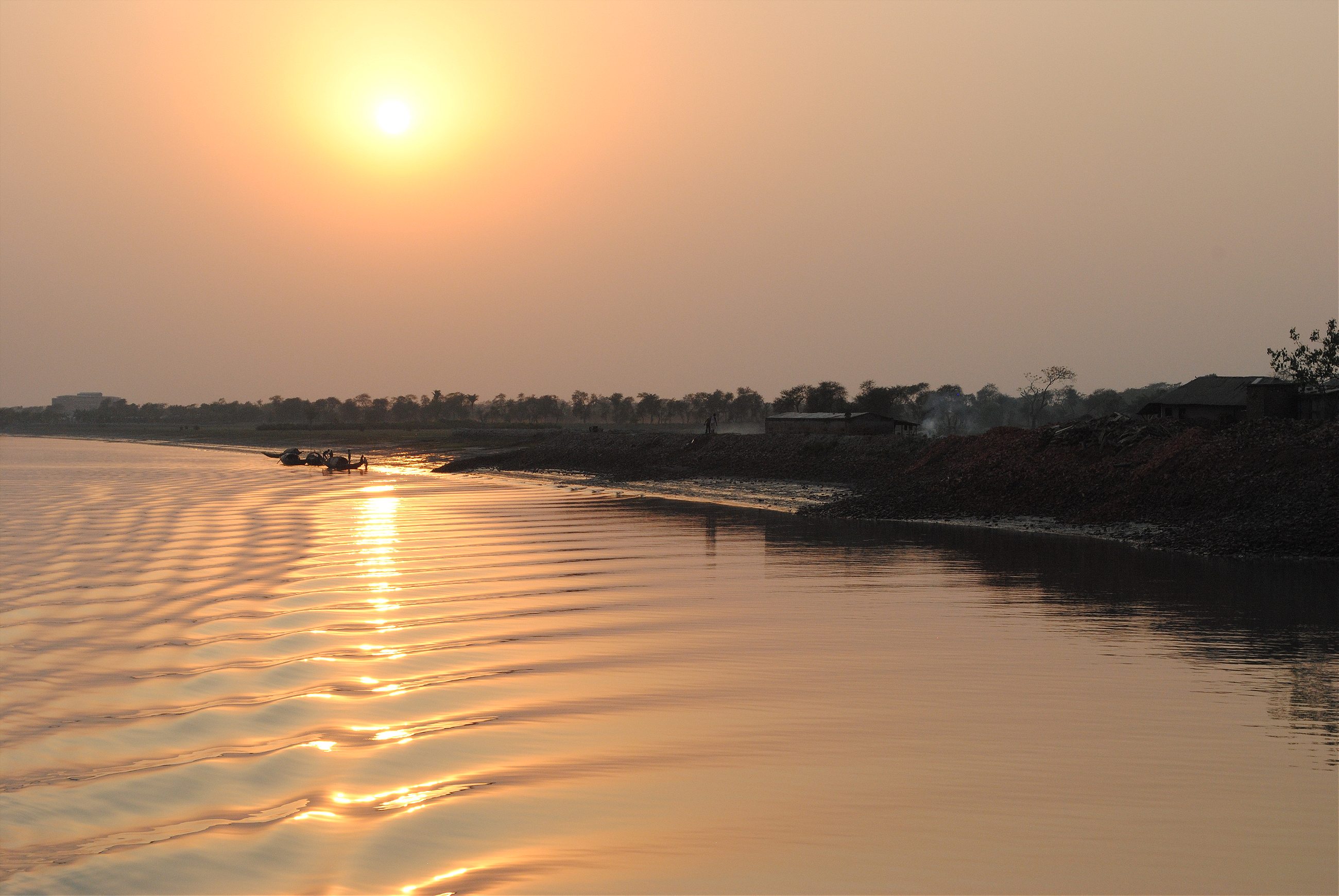
Treetops rustle and I see a villager high among the leaves vigorously shaking branches. Below him, lungi-clad men pick up long brown tamarind pods containing sour fruit. Their bodies are all lean muscle from days of farming, climbing trees, carrying wood, and heavy loads. They have also plucked some green coconuts from a tree. One man expertly hacks off the top with a few swipes of a machete. I drink the refreshing juice inside from my bowling ball-sized cup.
But this peace could be easily destroyed by the wrath of the next cyclone. And each day there are inexorable changes threatening life here. Shekhar Chandra Mondal, 55, says his ancestors have lived in Banishanta for a century. Now there is less rain and crops are sparser. Freshwater ponds are receding. He points to the green coconut in my hands and observes that even these fruits used to be much bigger.
Like the shifting tidal waters surrounding them, the inhabitants of the Sundarbans can’t control the changes but can only try to live with them. The waters are too hungry and too strong.